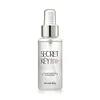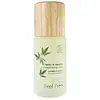What's inside
What's inside
 Key Ingredients
Key Ingredients

 Benefits
Benefits

 Concerns
Concerns

 Ingredients Side-by-side
Ingredients Side-by-side

Water
Skin ConditioningButylene Glycol
HumectantGlycerin
HumectantAlcohol Denat.
AntimicrobialGalactomyces Ferment Filtrate
HumectantCeramide NP
Skin ConditioningAloe Barbadensis Leaf Extract
EmollientChamomilla Recutita Extract
Skin ConditioningCentella Asiatica Extract
CleansingCamellia Sinensis Leaf Extract
AntimicrobialHamamelis Virginiana Extract
AntiseborrhoeicOryza Sativa Bran Extract
Skin ConditioningPortulaca Oleracea Extract
Skin ConditioningPanax Ginseng Root Extract
EmollientAcanthopanax Senticosus Root Extract
Skin ConditioningOligopeptide-1
Skin ConditioningSodium Hyaluronate
HumectantOctyldodecanol
EmollientHydrogenated Lecithin
EmulsifyingBoswellia Serrata Resin Extract
SmoothingPEG-60 Hydrogenated Castor Oil
EmulsifyingCaprylhydroxamic Acid
Caprylyl Glycol
Emollient1,2-Hexanediol
Skin ConditioningDisodium EDTA
Parfum
MaskingWater, Butylene Glycol, Glycerin, Alcohol Denat., Galactomyces Ferment Filtrate, Ceramide NP, Aloe Barbadensis Leaf Extract, Chamomilla Recutita Extract, Centella Asiatica Extract, Camellia Sinensis Leaf Extract, Hamamelis Virginiana Extract, Oryza Sativa Bran Extract, Portulaca Oleracea Extract, Panax Ginseng Root Extract, Acanthopanax Senticosus Root Extract, Oligopeptide-1, Sodium Hyaluronate, Octyldodecanol, Hydrogenated Lecithin, Boswellia Serrata Resin Extract, PEG-60 Hydrogenated Castor Oil, Caprylhydroxamic Acid, Caprylyl Glycol, 1,2-Hexanediol, Disodium EDTA, Parfum
Water
Skin ConditioningAloe Barbadensis Leaf Juice
Skin ConditioningGlycerin
HumectantGluconolactone
Skin ConditioningSodium Hyaluronate
HumectantCannabis Sativa Seed Extract
EmollientCentella Asiatica Extract
CleansingCucumis Sativus Fruit Extract
EmollientChlorophyllin-Copper Complex
AntioxidantDecyl Glucoside
CleansingSodium Phytate
Citric Acid
BufferingSodium Levulinate
Skin ConditioningSodium Benzoate
MaskingPotassium Sorbate
PreservativeAlcohol
AntimicrobialParfum
MaskingLinalool
PerfumingWater, Aloe Barbadensis Leaf Juice, Glycerin, Gluconolactone, Sodium Hyaluronate, Cannabis Sativa Seed Extract, Centella Asiatica Extract, Cucumis Sativus Fruit Extract, Chlorophyllin-Copper Complex, Decyl Glucoside, Sodium Phytate, Citric Acid, Sodium Levulinate, Sodium Benzoate, Potassium Sorbate, Alcohol, Parfum, Linalool
Ingredients Explained
These ingredients are found in both products.
Ingredients higher up in an ingredient list are typically present in a larger amount.
Centella Asiatica Extract (Centella) is derived from an herb native to Southeast Asia. It is famous for its anti-inflammatory and soothing properties.
Centella is rich in antioxidants and amino acids, such as Madecassic Acid and Asiaticoside.
Studies show the compounds in centella help with:
The combination of all these properties makes centella effective at soothing, hydrating, and protecting the skin.
Other great components of centella include Vitamin A, vitamin C, several B vitamins, and Asiatic Acid.
Fun fact: Centella has been used as a medicine and in food for many centuries. As a medicine, it is used to treat burns, scratches, and wounds.
Learn more about Centella Asiatica ExtractGlycerin is already naturally found in your skin. It helps moisturize and protect your skin.
A study from 2016 found glycerin to be more effective as a humectant than AHAs and hyaluronic acid.
As a humectant, it helps the skin stay hydrated by pulling moisture to your skin. The low molecular weight of glycerin allows it to pull moisture into the deeper layers of your skin.
Hydrated skin improves your skin barrier; Your skin barrier helps protect against irritants and bacteria.
Glycerin has also been found to have antimicrobial and antiviral properties. Due to these properties, glycerin is often used in wound and burn treatments.
In cosmetics, glycerin is usually derived from plants such as soybean or palm. However, it can also be sourced from animals, such as tallow or animal fat.
This ingredient is organic, colorless, odorless, and non-toxic.
Glycerin is the name for this ingredient in American English. British English uses Glycerol/Glycerine.
Learn more about GlycerinParfum is a catch-all term for an ingredient or more that is used to give a scent to products.
Also called "fragrance", this ingredient can be a blend of hundreds of chemicals or plant oils. This means every product with "fragrance" or "parfum" in the ingredients list is a different mixture.
For instance, Habanolide is a proprietary trade name for a specific aroma chemical. When used as a fragrance ingredient in cosmetics, most aroma chemicals fall under the broad labeling category of “FRAGRANCE” or “PARFUM” according to EU and US regulations.
The term 'parfum' or 'fragrance' is not regulated in many countries. In many cases, it is up to the brand to define this term.
For instance, many brands choose to label themselves as "fragrance-free" because they are not using synthetic fragrances. However, their products may still contain ingredients such as essential oils that are considered a fragrance by INCI standards.
One example is Calendula flower extract. Calendula is an essential oil that still imparts a scent or 'fragrance'.
Depending on the blend, the ingredients in the mixture can cause allergies and sensitivities on the skin. Some ingredients that are known EU allergens include linalool and citronellol.
Parfum can also be used to mask or cover an unpleasant scent.
The bottom line is: not all fragrances/parfum/ingredients are created equally. If you are worried about fragrances, we recommend taking a closer look at an ingredient. And of course, we always recommend speaking with a professional.
Learn more about ParfumSodium Hyaluronate is hyaluronic acid's salt form. It is commonly derived from the sodium salt of hyaluronic acid.
Like hyaluronic acid, it is great at holding water and acts as a humectant. This makes it a great skin hydrating ingredient.
Sodium Hyaluronate is naturally occurring in our bodies and is mostly found in eye fluid and joints.
These are some other common types of Hyaluronic Acid:
Learn more about Sodium HyaluronateWater. It's the most common cosmetic ingredient of all. You'll usually see it at the top of ingredient lists, meaning that it makes up the largest part of the product.
So why is it so popular? Water most often acts as a solvent - this means that it helps dissolve other ingredients into the formulation.
You'll also recognize water as that liquid we all need to stay alive. If you see this, drink a glass of water. Stay hydrated!
Learn more about Water